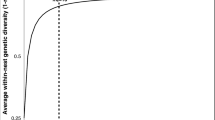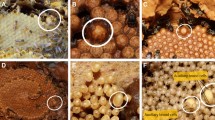Abstract
Inbreeding frequently has a costly impact on fitness, thus selection has favoured the evolution of kin recognition and inbreeding avoidance behaviour in many species. As haplodiploid Hymenoptera, bumblebees are susceptible to additional costs of inbreeding due to their single-locus complementary sex determination (sl-CSD) system, which means that incest can result in the production of costly diploid males. Here we test whether Bombus terrestris reproductives are able to discriminate between kin and non-kin and whether their willingness to mate is adjusted accordingly. We found that B. terrestris reproductives took significantly longer to mate with siblings compared to non-relatives. This indicates that this species exhibits kin recognition and uses this information to determine mating behaviour.
Zusammenfassung
Bei vielen Tierarten führt die Paarung mit nahen Verwandten bei den Nachkommen zu einer geringerer Fitness, ein Phänomen, das als Inzuchtdepression bekannt ist. Solche Arten sollten daher in der Lage sein, ihre Verwandten zu erkennen und eine Paarung mit ihnen zu vermeiden. Das Ziel dieses Experimentes war es zu prüfen, ob Hummeln aus der Art Bombus terrestris ihre Verwandten erkennen können, da Hummeln allgemein als besonders anfällig gegenüber Inzuchteffekte gelten. Dies vor allem deshalb, da aufgrund der genetischen Strukturen im Hummelvolk die Paarung zwischen verwandten Individuen zu diploiden Männchen führen kann. Diploide Männchen sind steril und werden auf Kosten der fleißigen Arbeiterinnen produziert, wodurch das Hummelvolk geschwächt wird. Daher sollte die natürliche Selektion zu Verwandtschaftserkennung und Inzuchtvermeidung führen, um die Kosten für die Produktion diploider Männchen zu umgehen. Das Paarungsexperiment wurde in einem großen Flugkäfig (70 cm × 70 cm × 70 cm) aus Gaze durchgeführt und den jungen Königinnen wurden entweder ihre Brüder oder unverwandte Männchen als Paarungspartner angeboten. Die Bereitschaft der Königinnen sich mit ihren Brüdern bzw. den unverwandten Männchen zu paaren wurde ermittelt, indem die Zeitspanne zwischen dem Freilassen der Paarungspartner (Königin und Männchen) und der erfolgreichen Kopulation gemessen wurde. Durchschnittlich 10,8 Minuten (± 0,94) vergingen, bis eine Verwandtenpaarung stattfand, während im Durchschnitt lediglich 4,5 Minuten (± 1,15) für eine Paarung zwischen nicht verwandten Partnern benötigt wurden. Diese Ergebnisse lassen vermuten, dass B. terrestris die Fähigkeit zur Verwandtschaftserkennung besitzt und entsprechend dem Verwandtschaftsgrad das Paarungsverhalten ändert. Weitere Untersuchungen sollten die Mechanismen der Verwandtschaftserkennung aufklären.
Similar content being viewed by others
References
Alford D.V. (1975) Bumblebees Davis-Poynter, London.
Ayabe T., Hoshiba H., Ono M. (2004) Cytological evidence for triploid males and females in the bumblebee, Bombus terrestris, Chromosome Res. 12, 215–223.
Baer B. (2003) Bumblebees as model organisms to study male sexual selection in social insects, Behav. Ecol. Sociobiol. 54, 521–533.
Barnard C.J., Aldhous P. (1991) Kinship, kin discrimination and mate choice, in: Hepper P.G. (Ed.), Kin recognition, Cambridge University Press, Cambridge, pp. 125–146.
Birkhead T.R., Pizzari T. (2002) Postcopulatory sexual selection, Nat. Rev. Genet. 3, 262–273.
Blaustein A.R. (1983) Kin Recognition Mechanisms — Phenotypic Matching Or Recognition Alleles, Am. Nat. 121, 749–754.
Colegrave N., Kotiaho J.S., Tomkins J.L. (2002) Mate choice or polyandry: reconciling genetic compatibility and good genes sexual selection, Evol. Ecol. Res. 4, 911–917.
Cook J.M., Crozier R.H. (1995) Sex determination and population biology in the Hymenoptera, Trends Ecol. Evol. 10, 281–286.
Darvill B., Ellis J.S., Lye G.C., Goulson D. (2006) Population structure and inbreeding in a rare and declining bumblebee, Bombus muscorum (Hymenoptera: Apidae), Mol. Ecol. 15, 601–611.
Djegham Y., Verhaeghe J.C., Rasmont P. (1994) Copulation of Bombus terrestris L. (Hymenoptera, Apidae) in captivity, J. Apicult. Res. 33, 15–20.
Duchateau M.J., Hoshiba H., Velthuis H.H.W. (1994) Diploid males in the bumble bee Bombus terrestris, sex determination, sex alleles and viability, Entomol. Exp. Appl. 71, 263–269.
Duchateau M.J., Marien J. (1995) Sexual biology of haploid and diploid males in the bumble bee Bombus terrestris, Insectes Soc. 42, 255–266.
Duvoisin N., Baer B., Schmid-Hempel P. (1999) Sperm transfer and male competition in a bumblebee, Anim. Behav. 58, 743–749.
Estoup A., Scholl A., Pouvreau A., Solignac M. (1995) Monoandry and polyandry in bumble bees (Hymenoptera — Bombinae) as evidenced by highly variable microsatellites, Mol. Ecol. 4, 89–93.
Foster R.L. (1992) Nestmate recognition as an inbreeding avoidance mechanism in bumble bees (Hymenoptera, Apidae), J. Kansas Entomol. Soc. 65, 238–243.
Frommen J.G., Luz C., Bakker T.C.M. (2007) Kin discrimination in sticklebacks is mediated by social learning rather than innate recognition, Ethology 113, 276–282.
Gamboa G.J., Grudzien T.A., Espelie K.E., Bura E.A. (1996) Kin recognition pheromones in social wasps: Combining chemical and behavioural evidence, Anim. Behav. 51, 625–629.
Gerloff C.U., Ottmer B.K., Schmid-Hempel P. (2003) Effects of inbreeding on immune response and body size in a social insect, Bombus terrestris, Funct. Ecol. 17, 582–589.
Gerloff C.U., Schmid-Hempel P. (2005) Inbreeding depression and family variation in a social insect, Bombus terrestris (Hymenoptera: Apidae), Oikos 111, 67–80.
Halliday T.R. (1983) The study of mate choice, in: Bateson P. (Ed.), Mate choice, Cambridge University Press, Cambridge, pp. 3–32.
Herzner G., Schmitt T., Heckel F., Schreier P., Strohm E. (2006) Brothers smell similar: Variation in the sex pheromone of male European Beewolves Philanthus triangulum F. (Hymenoptera: Crabronidae) and its implications for inbreeding avoidance, Biol. J. Linnean Soc. 89, 433–442.
Holmes W.G., Sherman P.W. (1982) The ontogeny of kin recognition in two species of ground squirrels, Am. Zool. 22, 491–517.
Holmes W.G., Sherman P.W. (1983) Kin recognition in animals, Am. Sci. 71, 46–55.
Keller L., Passera L. (1993) Incest avoidance, fluctuating asymmetry, and the consequences of inbreeding in Iridomyrmex humilis, an ant with multiple queen colonies, Behav. Ecol. Sociobiol. 33, 191–199.
Keller L., Ross K.G. (1998) Selfish genes: a green beard in the red fire ant, Nature 394, 573–575.
Kindl J., Hovorka O., Urbanova K., Valterova I. (1999) Scent marking in male premating behavior of Bombus confusus, J. Chem. Ecol. 25, 1489–1500.
Lihoreau M., Zimmer C., Rivault C. (2007) Kin recognition and incest avoidance in a group-living insect, Behav. Ecol. 18, 880–887.
Plowright R.C., Pallett M.J. (1979) Worker-male conflict and inbreeding in bumble bees (Hymenoptera-Apidae), Can. Entomol. 111, 289–294.
Pusey A., Wolf M. (1996) Inbreeding avoidance in animals, Trends Ecol. Evol. 11, 201–206.
Sauter A., Brown M.J.F. (2001) To copulate or not? The importance of female status and behavioural variation in predicting copulation in a bumblebee, Anim. Behav. 62, 221–226.
Schmid-Hempel R., Schmid-Hempel P. (2000) Female mating frequencies in Bombus spp. from Central Europe, Insectes Soc. 47, 36–41.
Shellman-Reeve J.S. (2001) Genetic relatedness and partner preference in a monogamous, wood-dwelling termite, Anim. Behav. 61, 869–876.
Simmons L.W. (1989) Kin recognition and its influence on mating preferences of the field cricket, Gryllus bimaculatus (Degeer), Anim. Behav. 38, 68–77.
Smith B.H., Ayasse M. (1987) Kin-based male mating preferences in two species of halictine bee, Behav. Ecol. Sociobiol. 20, 313–318.
Smith B.H., Wenzel J.W. (1988) Pheromonal covariation and kinship in social bee Lasioglossum zephyrum (Hymenoptera, Halictidae), J. Chem. Ecol. 14, 87–94.
Takahashi J., Ayabe T., Mitsuhata M., Shimizu I., Ono M. (2008) Diploid male production in a rare and locally distributed bumblebee, Bombus florilegus (Hymenoptera, Apidae), Insectes Soc. 55, 43–50.
Tang-Martinez Z. (2001) The mechanisms of kin discrimination and the evolution of kin recognition in vertebrates: a critical re-evaluation, Behav. Proc. 53, 21–40.
Tasei J.N., Moinard C., Moreau L., Himpens B., Guyonnaud S. (1998) Relationship between aging, mating and sperm production in captive Bombus terrestris, J. Apicult. Res. 37, 107–113.
Todrank J., Heth G. (2003) Odor-genes covariance and genetic relatedness assessments: rethinking odour based “recognition” mechanisms in rodents, Adv. Study Behav. 32, 77–130.
Tregenza T., Wedell N. (2002) Polyandrous females avoid costs of inbreeding, Nature 415, 71–73.
Whitehorn P.R., Tinsley M.C., Brown M.J.F., Darvill B., Goulson D. (2009) Impacts of inbreeding on bumblebee colony fitness under field conditions, BMC Evol. Biol. 9, 152.
Williams P.H. (1991) The bumble bees of the Kashmir Himalaya (Hymenoptera: Apidae, Bombini), Bull. Br. Mus. Nat. Hist. (Entomol.) 60, 1–204.
Zayed A., Packer L. (2005) Complementary sex determination substantially increases extinction proneness of haplodiploid populations, Proc. Natl Acad. Sci. (USA) 102, 10742–10746.
Author information
Authors and Affiliations
Corresponding author
Additional information
Manuscript editor: Jean-Noël Tasei
Rights and permissions
About this article
Cite this article
Whitehorn, P.R., Tinsley, M.C. & Goulson, D. Kin recognition and inbreeding reluctance in bumblebees. Apidologie 40, 627–633 (2009). https://doi.org/10.1051/apido/2009050
Received:
Revised:
Accepted:
Issue Date:
DOI: https://doi.org/10.1051/apido/2009050




